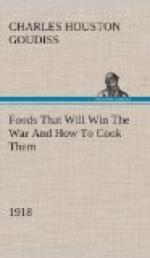In making yeast breads, the essential ingredient is gluten, which is extended by carbon dioxide gas formed by yeast growth. With the exception of rye, grains other than wheat do not contain sufficient gluten for yeast bread, and it is necessary to use a wheat in varying proportions in order to supply the deficient gluten. Even the baker’s rye loaf is usually made of one-half rye and one-half wheat. This is the safest proportion for home use in order to secure a good texture.
When oatmeal is used, it is necessary to scald the oatmeal to prevent a raw taste. Oatmeal also makes a softer dough than wheat, and it is best to make the loaf smaller and bake it longer: about one hour instead of the forty-five minutes which we allow for wheat bread.
The addition of one-third barley flour to wheat flour makes a light colored, good flavored bread. If a larger proportion than this is used, the loaf has a decided barley flavor. If you like this flavor and increase the proportion of barley, be sure to allow the dough a little longer time to rise, as by increasing the barley you weaken the gluten content of your loaf.
Rice and cornmeal can be added to wheat breads in a 10 per cent. proportion. Laboratory tests have shown that any greater proportion than this produces a heavy, small loaf.
Potato flour or mashed potato can be used to extend the wheat, it being possible to work in almost 50 per cent. of potato, but this makes a darker and moister loaf than when wheat alone is used. In order to take care of this moisture, it is best to reserve part of the wheat for the second kneading.
Graham and entire wheat flour also effect a saving of wheat because a larger percentage of the wheat berry is used. Graham flour is the whole kernel of wheat, ground. Entire wheat flour is the flour resulting from the grinding of all but the outer layer of wheat. A larger use of these coarser flours will therefore help materially in eking out our scant wheat supply as the percentage of the wheat berry used for bread flour is but 72 per cent. Breads made from these coarser flours also aid digestion and are a valuable addition to the dietary.
In order to keep down waste by eliminating the poor batch of bread, it is necessary to understand the principles of bread-making. Fermentation is the basic principle of yeast bread, and fermentation is controlled by temperature. The yeast plant grows at a temperature from 70 to 90 degrees (Fahrenheit), and if care is taken to maintain this temperature during the process of fermentation, waste caused by sour dough or over-fermentation will be eliminated. When we control the temperature we can also reduce the time necessary for making a loaf of bread, or several loaves of bread as may be needed, into as short a period as three hours. This is what is known as the quick method. It not only saves time and labor, but, controlling the temperature, insures accurate results. The easiest way to control




